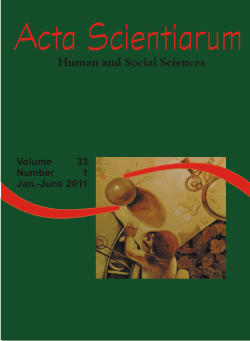<b>The tourism in the geographic optics</b> - doi: 10.4025/actascihumansoc.v33i1.9089
Keywords:
tourism, leisure, environment
Abstract
The tourism represents a human activity where the population’s turbulences may be alleviated, contributing for the human displacements as a direct result from their needs and desires. The tourism is also remarkable in great metropolis, where there are several activities for leisure to escape from the stress caused by the hustle and bustle of large cities. Tourists also look for diverse places for several reasons, such as: adventure and excitement, nature and landscape, purchases, culture, history etc. The socio-cultural factors are responsible, in great part, by the main attractions of the tourism in many Brazilian regions, and among the several types of tourism, the most notable ones are those ones related to the environment, as ecotourism and agritourism, important elements for local and regional development. This research aimed to discuss the conceptual basis of the tourism and the theoretical and methodological foundations. For this, we accomplished a literature review through books, periodicals, magazines and websites, and also the use of concepts by several authors, where we examined the information referring to the subject. As result, we obtained information about concepts from numerous authors about the tourism. The practical results expected consist of the spreading of this study and possible contributions to researches similar to this subject.Downloads
Download data is not yet available.
Published
2011-02-24
How to Cite
Grizio, E. V. (2011). <b>The tourism in the geographic optics</b> - doi: 10.4025/actascihumansoc.v33i1.9089. Acta Scientiarum. Human and Social Sciences, 33(1), 97-105. https://doi.org/10.4025/actascihumansoc.v33i1.9089
Issue
Section
Geography
DECLARATION OF ORIGINALITY AND COPYRIGHTS
I Declare that current article is original and has not been submitted for publication, in part or in whole, to any other national or international journal.
The copyrights belong exclusively to the authors. Published content is licensed under Creative Commons Attribution 4.0 (CC BY 4.0) guidelines, which allows sharing (copy and distribution of the material in any medium or format) and adaptation (remix, transform, and build upon the material) for any purpose, even commercially, under the terms of attribution.
Read this link for further information on how to use CC BY 4.0 properly.























